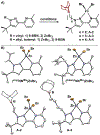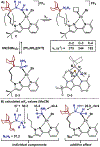Mobility of Lewis acids within the secondary coordination sphere: toward a model for cooperative substrate binding
- PMID: 33016291
- PMCID: PMC7606458
- DOI: 10.1039/d0cc05121g
Mobility of Lewis acids within the secondary coordination sphere: toward a model for cooperative substrate binding
Abstract
Distance dependence of appended Lewis acids in N2H4 binding and deprotonation was evaluated within a series of zinc complexes. Variation of spacer-length to a tethered trialkylborane Lewis acid revealed distinct preferences for binding and stabilization of the resulting deprotonated N2H3- unit.
Conflict of interest statement
Conflicts of interest
There are no conflicts to declare.
Figures




Similar articles
-
Hydrazine Capture and N-N Bond Cleavage at Iron Enabled by Flexible Appended Lewis Acids.J Am Chem Soc. 2017 Dec 20;139(50):18194-18197. doi: 10.1021/jacs.7b11465. Epub 2017 Dec 11. J Am Chem Soc. 2017. PMID: 29227655 Free PMC article.
-
A transition metal Lewis acid/base triad system for cooperative substrate binding.J Am Chem Soc. 2013 Mar 6;135(9):3403-6. doi: 10.1021/ja400962h. Epub 2013 Feb 25. J Am Chem Soc. 2013. PMID: 23421523
-
Synthesis of pyridine N-oxide-BF₂CF₃ complexes and their fluorescence properties.Chem Asian J. 2014 Apr;9(4):1026-30. doi: 10.1002/asia.201301688. Epub 2014 Feb 12. Chem Asian J. 2014. PMID: 24519930
-
On the Aggregation and Sensing Properties of Zinc(II) Schiff-Base Complexes of Salen-Type Ligands.Molecules. 2019 Jul 9;24(13):2514. doi: 10.3390/molecules24132514. Molecules. 2019. PMID: 31324053 Free PMC article. Review.
-
Recent developments in catalytic asymmetric inverse-electron-demand Diels-Alder reaction.Chem Rev. 2013 Jul 10;113(7):5515-46. doi: 10.1021/cr300436a. Epub 2013 Mar 25. Chem Rev. 2013. PMID: 23521039 Review. No abstract available.
Cited by
-
Distinct Reactivity Modes of a Copper Hydride Enabled by an Intramolecular Lewis Acid.J Am Chem Soc. 2022 Aug 24;144(33):15038-15046. doi: 10.1021/jacs.2c02937. Epub 2022 Aug 12. J Am Chem Soc. 2022. PMID: 35960993 Free PMC article.
-
A Bidentate Ligand Featuring Ditopic Lewis Acids in the Second Sphere for Selective Substrate Capture and Activation.Angew Chem Int Ed Engl. 2023 Mar 20;62(13):e202218907. doi: 10.1002/anie.202218907. Epub 2023 Feb 20. Angew Chem Int Ed Engl. 2023. PMID: 36720708 Free PMC article.
-
Synthesis and reactivity of a tris(carbene) zinc chloride complex.Dalton Trans. 2022 Oct 4;51(38):14563-14567. doi: 10.1039/d2dt02809c. Dalton Trans. 2022. PMID: 36074723 Free PMC article.
-
Appended Lewis Acids Enable Dioxygen Reactivity and Catalytic Oxidations with Ni(II).J Am Chem Soc. 2024 May 8;146(18):12375-12385. doi: 10.1021/jacs.3c12399. Epub 2024 Apr 25. J Am Chem Soc. 2024. PMID: 38661576 Free PMC article.
References
-
- Sawaya MR; Cannon GC; Heinhorst S; Tanaka S; Williams EB; Yeates TO; Kerfeld CA, J. Biol. Chem 2006, 281, 7546–7555; - PubMed
- Ferraroni M; Del Prete S; Vullo D; Capasso C; Supuran CT, Acta Cryst. D 2015, D71, 2449–2456; - PubMed
- Aggarwal M; Chua TK; Pinard MA; Szebenyi DM; McKenna R, Biochemistry 2015, 54, 6631–6638; - PMC - PubMed
- Cronk JD; Endrizzi JA; Cronk MR; O’Neill JW; Zhang KYJ, Protein Sci. 2001, 10, 911–922. - PMC - PubMed
-
- Miller AJM; Labinger JA; Bercaw JE, Organometallics 2010, 29, 4499–4516;
- Meng G; Lam NYS; Lucas EL; Saint-Denis TG; Verma P; Chekshin N; Yu J-Q, J. Am. Chem. Soc 2020, 142, 10571–10591; - PMC - PubMed
- Talukdar K; Sinha Roy S; Amatya E; Sleeper EA; Le Magueres P; Jurss JW, Inorg. Chem 2020, 59, 6087–6099; - PubMed
- González-Fernández R; Crochet P; Cadierno V, Dalton Trans. 2020, 49, 210–222; - PubMed
- Nichols Eva M.; Derrick JS; Nistanaki SK; Smith PT; Chang CJ, Chem. Sci 2018, 9, 2952–2960. - PMC - PubMed
MeSH terms
Substances
Grants and funding
LinkOut - more resources
Full Text Sources

